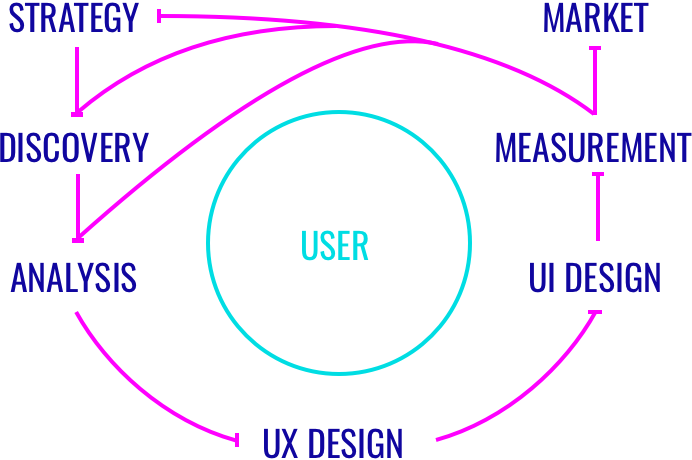DESIGN PROCESS
What is my design process? The short answer: it depends.
Design is a fundamentally creative act made better with structure. Established best practices and continually emerging methods should be mixed and merged as needed to fit within the triangulation of time, resources, and requirements. The design process should itself be designed.
My experience has led me to trust the backbone of process outlined here. Good process can be built from this:
BUILDING BLOCKS
Measurement feeds back into Analysis, creating the loop needed central to LEAN UX.
A USER-CENTRIC VIEW
The design process illustrated as a user-centric feedback loop:

Measurement will influence all steps, however UX Design inherits knowledge from the previous three. When possible, a designer should update Strategy, do any rediscovery, and reanalyze new data prior to diving back into UX.
KEY DESIGN DISCIPLINES
Design disciplines, in many contexts, can be thought of as nested blocks of increasingly specific skills, tools, and artifacts. I consider Visual Design and Interaction Design to be siblings within the larger framing discipline of User Interface Design.
UNPACKING DESIGN
Each design discipline contains specific skills, tools, and artifacts. Here is a closer, yet immediately incomplete, look at each step in the design process from above:
I. STRATEGY
A project benefits from a solid strategy. Here, the guiding principles, timeline, resources, goals, success metrics, ownership, and scheme are defined. Strategy sets the initial and overall shape of the project and provides challenges for the design team to solve.
II. DISCOVERY
Research is a critical step in the process. It is most important during project initiation but maintains value as Measurement provides new questions for the designer to answer.
Artifacts
- Personas
- Journey Maps
Tools
- User Interviews
- Card Sorting
- Heuristic Evaluation
- Existing Customer Feedback
- Support Pain-points
III. ANALYSIS
Both Discovery and Measurement lead to Analysis. It is important to analyze data with as much of a cross-functional team as is available to bring varied perspectives and get the most out of research and testing results.
Artifacts
- Usability Reports
- Product Requirements & Priority
IV. UX DESIGN
The user's success is the product's success. UX Design defines all of the user-product interaction and maintains the widest and deepest possible perspective as a project matures.
Artifacts
- Information Architecture
- Workflow Diagrams
- Wireframes
- Paper & Low-fidelity Prototypes
Specific Skills
- Superb communication
- Ability to achieve stakeholder buy-in
- Attention to micro- and macro-level
V. UI DESIGN
Where UX Design is intangible, User Interface Design produces tangible artifacts that users can interact with. UI Design encompasses motion and interaction design disciplines as well as visual design. Here, the rubber meets the road.
Artifacts
- Interactive Prototypes
- High-fidelity Models
- Interactive Prototypes
- Red-lines and dev-ready documentation
- Design Language definition
- Accessibility & Localization plans
Specific Skills
- Interaction & Motion design
- Visual design & aesthetic control
- Typography
- Knowledge of development cost and architecture
- Accessibility & Localization plans
- Semiotics
VI. MEASUREMENT
Design is a rational art form, requiring data to prove and disprove existing design decisions. Measuring the user and the product are critical to continuous product improvement.
Artifacts
- Usage metrics
- Performance & speed metrics
- Task success metrics
- Qualitative data
Tools
- Digital analytics
- End-user interviews & case studies
- Product community engagement
VII. MARKET
With defensible proof of design success in hand, the product team can go to market. This step is distinct due to the market-facing design deliverables required to maximize a launch or update. UX design must consider all aspects of a user's product interaction, from their first brand experience to their last.
Artifacts
- Marketing collateral
Specific Skills
- Marketing campaign design
- Print & production design
- Technical and commercial writing ability
- Digital advertisement knowledge